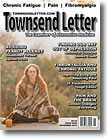|
Page 1, 2
This article describes the successful treatment using light therapy of three patients with peripheral neuropathy. The etiology of neuropathy for each of these patients was different, as were the patients themselves in age, sex, and general condition. All of the patients were significantly disabled and had previously undergone extensive conventional treatment without significant relief.
I have used light therapy to treat over 2000 patients with a variety of painful health conditions since 1999, when I first met Maurice Bales, who had extensive experience with the development and manufacturing of infrared light devices, beginning in the 1970s with his work at NASA and the Lawrence Livermore Lab. Maurice trained me to treat a wide range of painful conditions that included neuropathy, neck and back pain, TMJ disorders, headaches, fractures, and sports injuries. I have found that if something hurts, chances are that treatment with light will help.
Despite its remarkable effectiveness, safety profile, and affordability, light therapy remains for the most part underappreciated and underused. This lack of utilization of light therapies is not just by mainstream medicine but also by the alternative and integrative medical communities. This situation exists despite the fact that more than 70,000 peer-reviewed articles have been published on light therapy and listed on PubMed going back to 1899. Since then light therapy has been documented to relieve pain, increase circulation, reduce inflammation, speed up wound healing by an average of 40%, increase lymphatic drainage, attract stem cells, and stimulate mitochondrial production of ATP – among other things.1-15 This sounds a bit like Star-Trek medicine!
I have selected three case histories that demonstrate the range of peripheral neuropathies that can be treated using light therapy.
Case #1: Chemotherapy-Induced Peripheral Neuropathy
J. K. is a 69-year-old female referred by her oncologist for treatment of advanced peripheral neuropathy caused by chemotherapy. She was diagnosed in 2010 with colon cancer and was treated with surgery, chemotherapy, and radiation. She felt well and remained in remission until December 2014, at which time she was found to have stage IV disease based on diagnosing metastases to her lungs. She was started on chemotherapy with Erbitux.
Her cancer responded to this treatment, but within a few months she developed progressively worsening numbness in her hands and feet. By June 2015, she had such dense numbness that she could not feel the accelerator or brake in her car and was unable to button her clothing. She became depressed because she was for the most part confined to her home. Her oncologist referred her to me for treatment of her neuropathy because it had become so severe that chemotherapy had to be discontinued.
She was treated with 11 15-minute light treatments to her feet, legs, and hands from July 29, 2015, through August 20, 2015. She regained enough sensation in her fingers and feet that she can now drive, walk normally, and button her clothing without assistance. She is now much more active socially and is back on her chemotherapy treatment. She remains in remission and is enjoying life once again.
Pre-Tx Plantar Feet
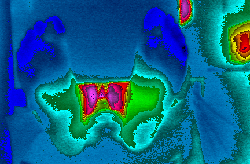
|
Post-Tx Plantar Feet
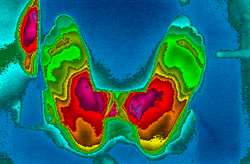
|
Pretreatment thermographic image of soles of feet show lack of circulation as blue and green colors. Posttreatment shows significantly increased circulation as red and orange.
Case #2: Trauma-Induced Neuropathy
T. S. is a 39-year-old woman who was in a tornado three years ago, when a large uprooted tree fell on her geodesic dome and crashed her to the ground. Ever since that event, she could not raise her arms above her neck; has been walking with a wide-based gait to maintain her balance; has been weak in both legs; tires easily; and developed numbness, burning pain, and tingling in her feet and lower legs.
Her podiatrist referred her to me to treat her peripheral neuropathy with light therapy.
The patient's examination revealed dense numbness extending from the bottoms of her feet to the midcalf. She had normal pedal pulses and no Babinski sign, but her knee and ankle reflexes were absent. Her lumbar spine had very significant bilateral pain to direct pressure from L3 to S1. The range of motion of her neck was restricted to 45 degrees bilaterally and there was moderate tenderness to palpation in the suboccipital portion of her neck. She also suffered from both lumbar disc disease and neuropathy.
She received seven treatments on her feet, low back, neck, and TMJ with light from July 15 through August 21, 2015. The patient reported, "Photonic stimulation has been a miracle for me. I no longer have pain when I stand or walk, and am able to straighten my knees. I walk with balance and at a normal speed, which I never imagined I would be able to do again. I am dreaming of getting a bike and returning to yoga and dance."
Posterior pre_Tx
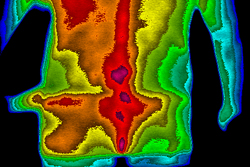
|
Posterior post-Tx
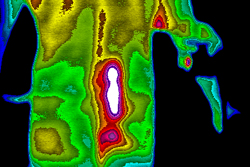
|
Pretreatment image shows inflammation in orange and red from a posterior radiculopathy. The posttreatment image shows a reduction in inflammation and more symmetrical pattern of heat distrubution. (The white spot is an artifact of the BioPhoton treatment.)
Case #3: Diabetic Neuropathy
R. S. is a 56-year-old male with a history of type 2 diabetes, hypertension, obesity, hyperlipidemia, and being a "wine connoisseur." He was referred by his chiropractor for treatment of his neuropathy with infrared light. His symptoms began in 2008 and included numbness and mild burning nighttime pain that had been progressive and assumed to be caused by type 2 diabetes. It is noteworthy that he was being treated with glipizide, amlopidine, hydrochlorothiazide, pravastatin, and nortriptyline, all of which have an association, albeit weak, with peripheral neuropathy. Odds are that the most likely cause in this case was a combination of diabetes and alcohol.
He was treated from January 2014 through June 2015 with 31 infrared light therapy treatments to his feet. The combination of gradually reducing his alcohol consumption and employing light treatments had a major effect on improving his neuropathy symptoms. At the present time has no pain and only mild numbness in his feet. His gait is normal. In addition to using light therapy, we have successfully focused on improving his lifestyle factors including stress, insomnia, diet, exercise, weight management, and reduction in alcohol consumption. Because of his compliance we have been able to discontinue all of his medications.
Pain management has become a very sophisticated discipline that tends to be complicated and often associated with challenging side effects. Light therapy is another story, because it is simple, effective, safe, and affordable. In contrast, in mainstream clinical practice, it is typical for patients with severe pain to be treated with a polypharmacy that usually includes drugs for pain, anxiety, depression, insomnia, and a wide range of additional drugs to manage their side effects. Many people take 10 or more drugs and, not unexpectedly, simply cannot function very well. These are often those patients who come to my office!
For some neuropathies, light treatment alone is sufficient to relieve even the most severe pain. I have been able to wean more than a thousand patients off their medications. For other painful conditions, it can be helpful to use an integrative team approach that can include chiropractic, Chinese medicine, bodywork, imagery, psychotherapy, pulsed electromagnetic field therapy, and so on.
I have found that the safest and most effective way to use light therapy is to use the right device under the guidance of infrared imaging in real time. The Bales Thermal Image Processor (TIP) that we employ is a high-resolution infrared camera which is highly stable and sensitive. It allows us to use light devices that can deliver the right wavelengths with enough power that we usually get impressive clinical improvement in just a single 15-minute office visit. This approach also allows patients to observe their infrared images in real time and see for themselves the impressive changes that occur during a treatment. So patients get great clinical results not only from the effects of light itself, but also from the effects of visualizing how the treatment changes the thermal patterns on their skin.
We have learned that with certain conditions, it is critical to follow the thermal effects of light during treatment so that we visualize what we're doing and also minimize any chance of making symptoms worse. This is especially important in people with fibromyalgia and other forms of neuropathic pain such as complex regional pain syndromes, shingles, certain vascular headaches, and several other conditions.
There are hundreds of light therapy devices available, greatly varying in their respective prices, mechanisms, and efficacy. The device that I began using in 1999 was the Bales Scientific Photonic Stimulator, in conjunction with the Bales TIP camera. When its inventor, Bales, worked for NASA and the Lawrence Livermore Labs, he was developing equipment used for the space shuttle. Starting in 1985, he began to adapt his work to the medical field, creating his thermographic camera in 1990 and the Photonic Stimulator, which was approved by the FDA as a medical device to treat pain in 1997. Bales has made dozens of incremental improvements to photonic stimulators over the past two decades. What is especially noteworthy about the three cases I discuss in this article is that I used a revolutionary new model introduced only this year, now called the BioPhoton 100. This device is significantly more powerful than its predecessors, offers variable wavelengths and frequencies, is considerably smaller, and costs less.
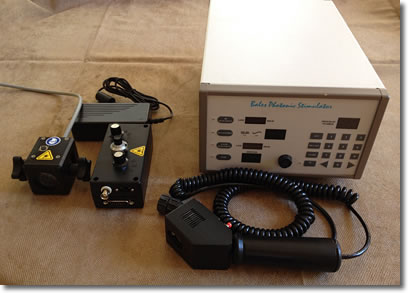 |
BioPhoton
Photonic Stimulator |
Here are some of the specific differences:
Power: Output power has been increased from 0.250 watts to 8.9 watts. Output power is a very important factor for permeation depth. While lower-powered devices may benefit cells at the superficial level, they fail to penetrate deeper tissue, which is often the root problem of a chronic disease. The BioPhoton can target tissues deep within the body and penetrate the skull to reach the brain. More power equates to more photon energy being transmitted to the cells, which also reduces the duration and number of treatments.
Spectrum wavelengths: The previous model had a fixed wavelength of 850 to 880 nm, while the BioPhoton 100 has mixed-spectrum blue light at wavelengths from 450 nm and red and far-infrared light up to 940 nm. Blue light only penetrates superficial tissues but can treat cutaneous conditions such as traumatic injuries such as burns, cuts, contusions, and even infections such as MRSA.16-18 Increasing the power of blue light can deliver substantial amounts to the deeper tissues. It should be noted that blue light has greater ability than red or infrared in releasing nitric oxide to cause vasodilation.19,20 Infrared wavelengths include 850 nm and 940 nm and have the actions mentioned earlier.
Modulation (waveform) options: The BioPhoton 100 Professional model can accept external input from other devices. This provides the practitioner with the ability to replicate other frequency protocols that can be customized to meet individual treatment goals. These protocols may include square, triangular, sine, or audio waveforms at varied frequencies. It has been theorized that different waveforms are beneficial in the treatment of various diseases.
Smaller size and lower price: The size of the device has gone from 14.5² × 10² × 6² down to 5.5² × 2.5² × 2.75.² The price of the original Photonic Stimulator was $9320 (in today's dollars), while models of the BioPhoton 100 range from $2200 to $7000. These improvements make it possible for practitioners to devise a treatment protocol and then rent the device to patients to use in their homes for a specified period. This allows for daily use, which equates to faster healing, and more satisfied patients. Home treatment allows for more regular treatments at a lower cost while freeing up more time for other patients.
Page 1, 2
|
![]()




